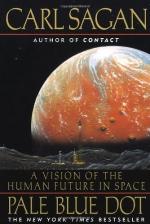
|
| Name: _________________________ | Period: ___________________ |
This quiz consists of 5 multiple choice and 5 short answer questions through Chapter 15, The Gates of the Wonder World Open, Chapter 16, Scaling Heaven.
Multiple Choice Questions
1. The records on the Voyager craft are most like what type of information storage method?
(a) A phonograph.
(b) A telegraph code.
(c) Magnetic data storage.
(d) Braille.
2. The Anthropic Principle is divided into two theories that are termed what?
(a) Strong and weak.
(b) Old and new.
(c) Orthodox and reformed.
(d) Greater and lesser.
3. Einstein's work undermined what concept?
(a) That our frame of motion is stationary.
(b) That the Sun is unique.
(c) That humans can travel to distant stars.
(d) That light is the fastest thing in the universe.
4. What does Neptune's moon have less of compared to Titan?
(a) Iron.
(b) Carbon.
(c) Ice.
(d) Potassium.
5. At the time this book was written, how many Mars Observers had been flown successfully?
(a) Three.
(b) One.
(c) None.
(d) Five.
Short Answer Questions
1. What element does Sagan say motivated the space programs of the 60s and 70s?
2. What is Neptune's largest moon?
3. What does Martian soil seem to contain?
4. How does Sagan say that science relates to the existence of a divine being?
5. How well does Sagan say his typical audience handles the practical details of a Mars mission?
|
This section contains 248 words (approx. 1 page at 300 words per page) |

|




